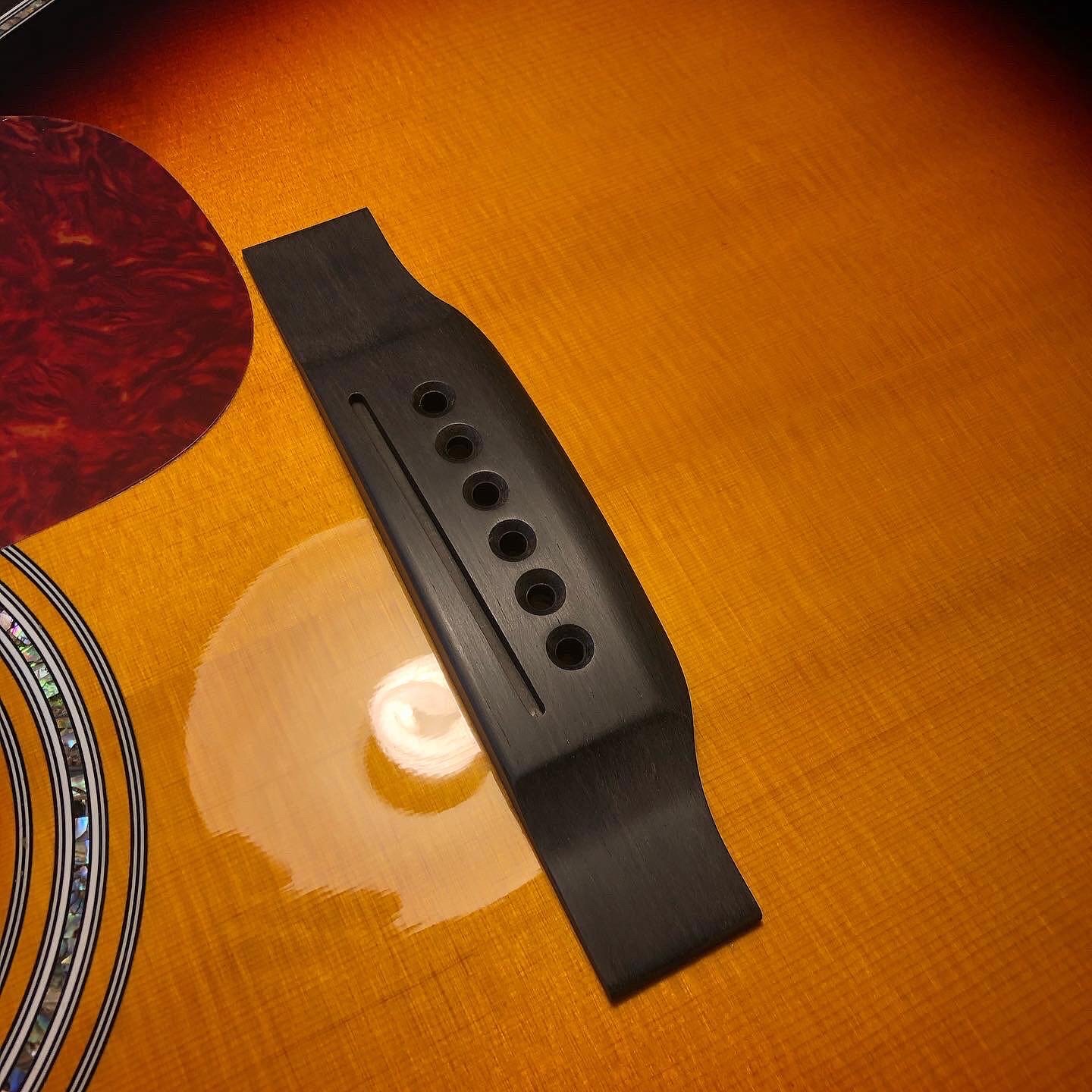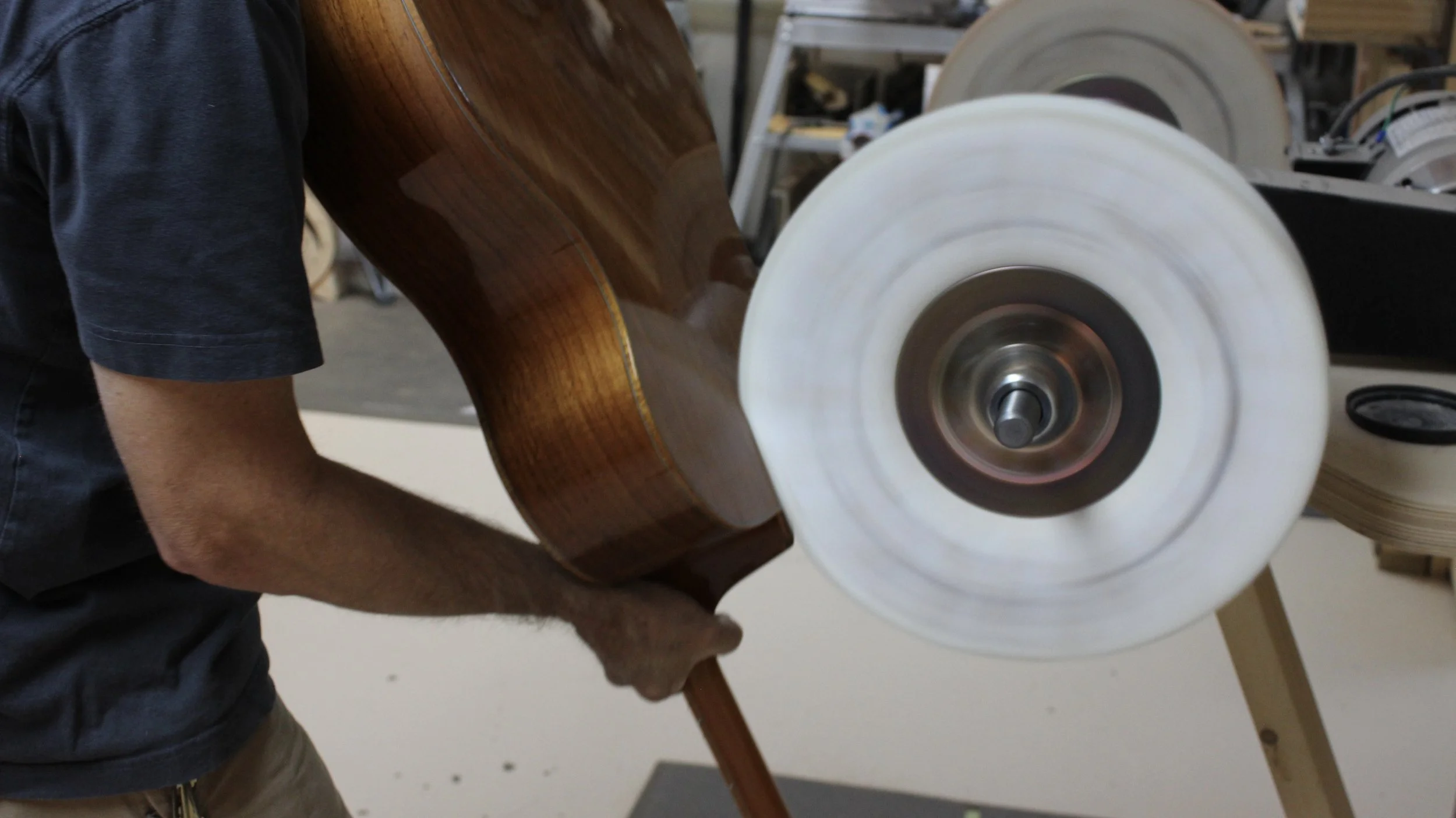Repairs
Minor Setup:
Clean Frets and Fret Board:
This is removing oxidation from the frets and dirt and grim from the fret board which make for a great playing surface.Adjust truss rod:
Adjusting the rod in the neck to make the fingerboard straight.Adjust witness points at the nut and saddle:
Moving the point where the string changes angles either toward the 1st fret at the nut or the proper intonation point on the saddle.Adjust action at nut and saddle:
Setting the height of the strings off the fret tops.Restring & tune:
Replacing the old strings and tuning the instrument.
Major Setup:
Dress frets:
Milling the high and/or worn fret top down until all fret tops are the same height -- relative to each other.
Clean frets and fret board:
Removing oxidation from the frets, dirt and grim from the fret board and improving the playing surface.Adjust truss rod:
Adjusting the rod in the neck to make the fingerboard straight.Adjust witness points at the nut and saddle:
Moving the point where the string changes angles either toward the 1st fret at the nut or the proper intonation point on the saddle.Adjust action at nut and saddle:
Setting the height of the strings off the fret tops.Restring & tune:
Replacing the old strings and tuning the instrument.
Fret Work:
Dress frets:
Milling the high and/or worn fret top down until all fret tops are the same height -- relative to each other.Re-fret:
Replacing the old and worn frets.Glue fret ends:
Sometimes frets and/or fret ends become loose and need to be glued tightly in the fret slot.
Neck Work:
Adjust truss rod:
Adjusting the rod in the neck to make the fingerboard straight.Fret work:
See Fret workPlaning the fingerboard:
After the frets have been removed, in most cases the fingerboard isn't straight, there are hills and valleys and worn areas on the fingerboard. Planing the fingerboard, sanding and planing, will make the fingerboard straight before installing new frets. This improves playability in any fretted instrument.
Neck reset:
Removing the neck from the body of the instrument and reinstalling it at the proper angle(s) to the body.
Nut Work:
New nut:
Removing the old nut and making and installing a new nut for the instrument.
Adjusting existing nut:
Adjusting the string height in the nut so the action at the first fret is at its best -- not buzzing and not too high.
Adjust witness points at the nut:
Moving the point where the string changes angles either toward the 1st fret at the nut.
Saddle work:
New Saddle:
Removing the old saddle and making and installing a new saddle.
Adjusting the existing saddle:
Adjusting the fit and height of the saddle so that it is correct.
Adjust witness points at the saddle:
Moving the point where the string changes angles either toward the 1st fret at the nut or the proper intonation point on the saddle.
Bridge work:
Re-glue:
Removing the existing bridge, removing the old glue from the bridge and the top of the instrument then re-gluing it.Installing a new bridge:
Removing the existing bridge that might be badly broken or cracked and installing a new bridge.Custom bridge:
Building a bridge by hand and installing it. Sometimes bridges are not available from the original manufacturer and a custom bridge is the best way to solve the problem.Bridge cracks repair:
Filling and/or closing a crack in a bridge and then gluing it. Bridges sometimes develop cracks due to string pressure and/or dryness.Bridge pad or plate repair:
Either repairing or replacing the bridge pad or plate in a instrument. The bridge pad or plate is the thin piece of wood usually maple, on the inside of the instrument that the ball-end of the string rests against. Over time the pad or plate can become worn and sometimes even crack and need to be repaired or replaced.Saddle slot repair:
In most cases this involves re-routing the saddle slot. When installing an under the saddle pickup, sometimes the saddle slot is not flat and the strings have uneven volume. The pressure of the saddle on the pickup needs to be equal under each string so the pickup works properly.
Sometimes the saddle slot is not in the right place for the instrument to play in tune. Filling the saddle slot with wood (rosewood and ebony are the most common) and re-routing a new slot can solve many of the intonation problems with most instruments.Fitting bridge pins:
Sometimes bridge pins are loose and the ball-end of the string is pulled in to the bridge pin hole. This can allow the heavier winding of the string(s) to set on top of the saddle and cause intonation problems along with bridge pad or plate problems as well.
Brace work:
Re-glue:
Gluing loose or broken, existing braces.Replace:
Making and installing a brace that is broken beyond repair or one that came unglued and was lost.
Crack work:
Gluing cracks in fingerboards, neck, tops, sides and backs. The type of crack(s), the type of wood and the type of finish on the instrument will determine how the work is done. Many times cleats are needed to support the weakened area.
Electronic work:
Repairing existing electronics and/or replacing with new electronics -- installing or repairing pickups, jacks, pots, wiring, switches, pre-amps, complete rewire, shielding, routing, etc.
Headstock work:
Gluing broken head-stocks, tuner installations, cracked or splitting head-stocks, etc.
Pickguard work:
Repairing the existing guard or replacing the old guard with new or custom guard. A new guard can sometimes change the sound of your instrument depending on the size and thickness of the material used.
Finish work:
Finish work is totally dependent on the type of finish and/or extent of damage to the instrument. WE DO NOT REFINISH INSTRUMENTS, but there are many instruments that have finish that can be touched up. Sometimes having the instrument buffed and polished can solve the problem. There are also instruments that you just don't want or need to touch up the finish on.
Tremolo work:
There are many issues that arise with tremolos. The action of the tremolo arm and the movement of the arm are common problems. The intonation and the action of the guitar are also common problems. Depending on the brand and type of tremolo on the instrument will determine the approach for the repair. We are constantly working with tension and counter-tension when setting up a tremolo correctly.
Other Work:
We also do inlay replacement and some custom work depending on the artwork. Strap button installation. Tuning machine work, depending on the tuners. We humidify and dehumidify instruments. Give us a call and we will help you if we can.
A Few Repair Process Photos
The start of removing a neck to be re-set.
Milling a custom rosewood Martin bridge.
Handmade unbleached bone nut.
Maple bridge retainer installed. (looking in a mirror)
Gibson ES-335 Re-fretted
A re-glued Martin bridge.
Re-gluing a bridge on a 1950s Gibson J-45
Buffing the back of a guitar.










